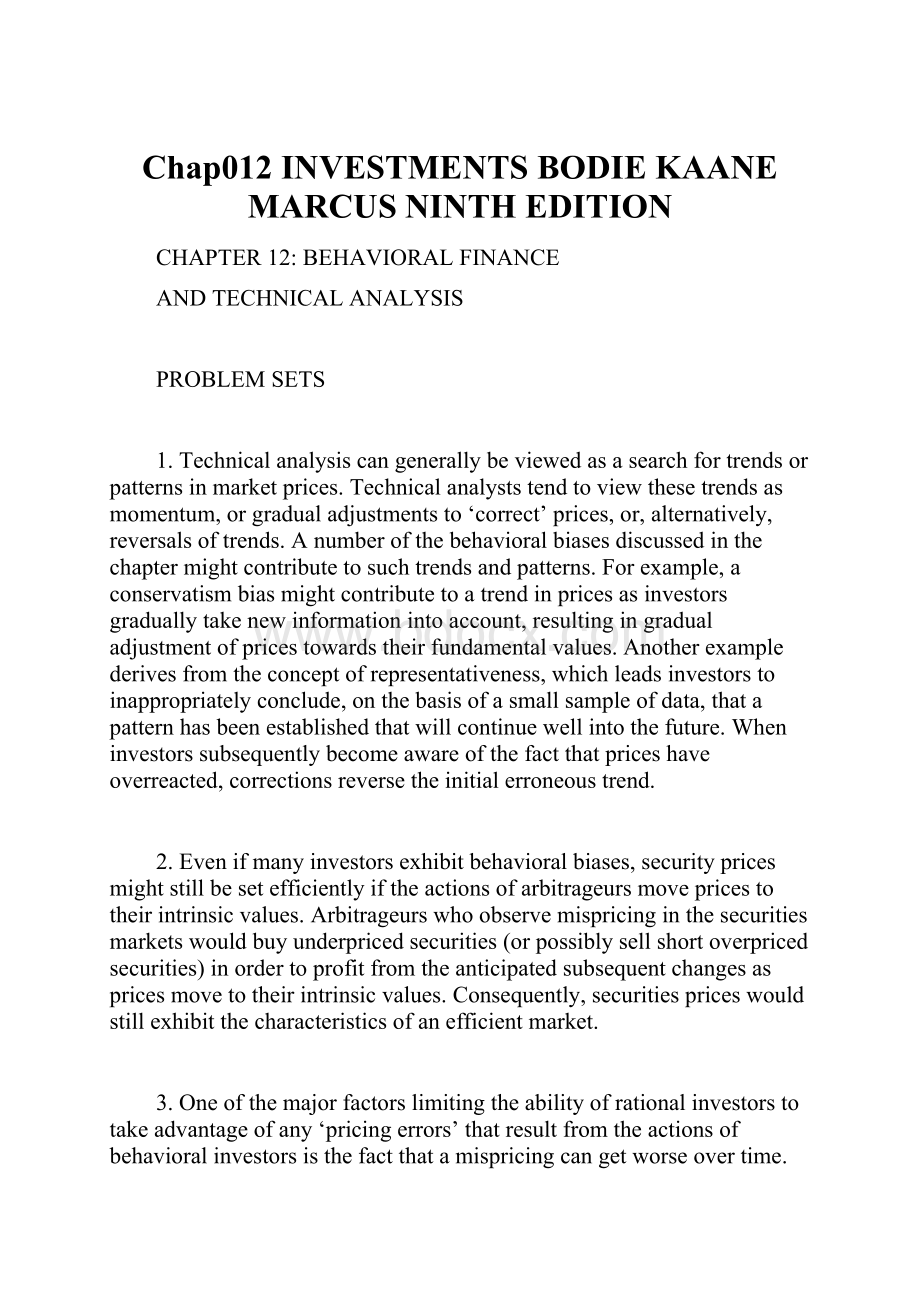Chap012INVESTMENTSBODIE KAANE MARCUSNINTH EDITION.docx
《Chap012INVESTMENTSBODIE KAANE MARCUSNINTH EDITION.docx》由会员分享,可在线阅读,更多相关《Chap012INVESTMENTSBODIE KAANE MARCUSNINTH EDITION.docx(18页珍藏版)》请在冰豆网上搜索。

Chap012INVESTMENTSBODIEKAANEMARCUSNINTHEDITION
CHAPTER12:
BEHAVIORALFINANCE
ANDTECHNICALANALYSIS
PROBLEMSETS
1.Technicalanalysiscangenerallybeviewedasasearchfortrendsorpatternsinmarketprices.Technicalanalyststendtoviewthesetrendsasmomentum,orgradualadjustmentsto‘correct’prices,or,alternatively,reversalsoftrends.Anumberofthebehavioralbiasesdiscussedinthechaptermightcontributetosuchtrendsandpatterns.Forexample,aconservatismbiasmightcontributetoatrendinpricesasinvestorsgraduallytakenewinformationintoaccount,resultingingradualadjustmentofpricestowardstheirfundamentalvalues.Anotherexamplederivesfromtheconceptofrepresentativeness,whichleadsinvestorstoinappropriatelyconclude,onthebasisofasmallsampleofdata,thatapatternhasbeenestablishedthatwillcontinuewellintothefuture.Wheninvestorssubsequentlybecomeawareofthefactthatpriceshaveoverreacted,correctionsreversetheinitialerroneoustrend.
2.Evenifmanyinvestorsexhibitbehavioralbiases,securitypricesmightstillbesetefficientlyiftheactionsofarbitrageursmovepricestotheirintrinsicvalues.Arbitrageurswhoobservemispricinginthesecuritiesmarketswouldbuyunderpricedsecurities(orpossiblysellshortoverpricedsecurities)inordertoprofitfromtheanticipatedsubsequentchangesaspricesmovetotheirintrinsicvalues.Consequently,securitiespriceswouldstillexhibitthecharacteristicsofanefficientmarket.
3.Oneofthemajorfactorslimitingtheabilityofrationalinvestorstotakeadvantageofany‘pricingerrors’thatresultfromtheactionsofbehavioralinvestorsisthefactthatamispricingcangetworseovertime.AnexampleofthisfundamentalriskistheapparentongoingoverpricingoftheNASDAQindexinthelate1990s.Arelatedfactoristheinherentcostsandlimitsrelatedtoshortselling,whichrestricttheextenttowhicharbitragecanforceoverpricedsecurities(orindexes)tomovetowardstheirfairvalues.Rationalinvestorsmustalsobeawareoftheriskthatanapparentmispricingis,infact,aconsequenceofmodelrisk;thatis,theperceivedmispricingmaynotberealbecausetheinvestorhasusedafaultymodeltovaluethesecurity.
4.Therearetworeasonswhybehavioralbiasesmightnotaffectequilibriumassetprices:
first,behavioralbiasesmightcontributetothesuccessoftechnicaltradingrulesaspricesgraduallyadjusttowardstheirintrinsicvalues,andsecond,theactionsofarbitrageursmightmovesecuritypricestowardstheirintrinsicvalues.Itmightbeimportantforinvestorstobeawareofthesebiasesbecauseeitherofthesescenariosmightcreatethepotentialforexcessprofitsevenifbehavioralbiasesdonotaffectequilibriumprices.
Inaddition,aninvestorshouldbeawareofhispersonalbehavioralbiases,evenifthosebiasesdonotaffectequilibriumprices,tohelpavoidsomeoftheseinformationprocessingerrors(e.g.overconfidenceorrepresentativeness).
5.Efficientmarketadvocatesbelievethatpubliclyavailableinformation(and,foradvocatesofstrong-formefficiency,eveninsiderinformation)is,atanypointintime,reflectedinsecuritiesprices,andthatpriceadjustmentstonewinformationoccurveryquickly.Consequently,pricesareatfairlevelssothatactivemanagementisveryunlikelytoimproveperformanceabovethatofabroadlydiversifiedindexportfolio.Incontrast,advocatesofbehavioralfinanceidentifyanumberofinvestorerrorsininformationprocessinganddecisionmakingthatcouldresultinmispricingofsecurities.However,thebehavioralfinanceliteraturegenerallydoesnotprovideguidanceastohowtheseinvestorerrorscanbeexploitedtogenerateexcessprofits.Therefore,intheabsenceofanyprofitablealternatives,evenifsecuritiesmarketsarenotefficient,theoptimalstrategymightstillbeapassiveindexingstrategy.
6.a.Davisuseslossaversionasthebasisforherdecisionmaking.Sheholdsontostocksthataredownfromthepurchasepriceinthehopesthattheywillrecover.Sheisreluctanttoacceptaloss.
7.a.Shrumrefusestofollowastockaftershesellsitbecauseshedoesnotwanttoexperiencetheregretofseeingitrise.Thebehavioralcharacteristicusedforthebasisforherdecisionmakingisthefearofregret.
8.a.Investorsattempttoavoidregretbyholdingontolosershopingthestockswillrebound.Ifthestockreboundstoitsoriginalpurchaseprice,thestockcanbesoldwithnoregret.Investorsalsomaytrytoavoidregretbydistancingthemselvesfromtheirdecisionsbyhiringafull-servicebroker.
9.a.–iv
b.–iii
c.–v
d.–i
e.–ii
10.Underlyingrisksstillexistevenduringamispricingevent.Themarketmispricingcouldgetworsebeforeitgetsbetter.Otheradverseeffectscouldoccurbeforethepricecorrectsitself(e.g.lossofclientswithnounderstandingorappetiteformispricingopportunities).
11.Dataminingistheprocessbywhichpatternsarepulledfromdata.Technicalanalystsmustbecarefulnottoengageindataminingasgreatisthehumancapacitytodiscernpatternswherenopatternsexist.Technicalanalystsmustavoidminingdatatosupportatheory,ratherthanusingdatatotestatheory.
12.Evenifpricesfollowarandomwalk,theexistenceofirrationalinvestorscombinedwiththelimitstoarbitragebyarbitrageursmayallowpersistentmispricingstobepresent.Thisimpliesthatcapitalwillnotbeallocatedefficiently—capitaldoesnotimmediatelyflowfromrelativelyunproductivefirmstorelativelyproductivefirms.
13.Trin=
Thistrinratio,whichisbelow1.0,wouldbetakenasabullishsignal.
14.Breadth:
Advances
Declines
NetAdvances
1,604
1,434
170
Breadthispositive—bullishsignal(noonewouldactuallyuseaone-daymeasure).
15.Thisexerciseislefttothestudent;answerswillvary.
16.Theconfidenceindexincreasesfrom(5%/6%)=0.833to(6%/7%)=0.857.
Thisindicatesslightlyhigherconfidencewhichwouldbeinterpretedbytechniciansasabullishsignal.Buttherealreasonfortheincreaseintheindexistheexpectationofhigherinflation,nothigherconfidenceabouttheeconomy.
17.Atthebeginningoftheperiod,thepriceofComputers,Inc.dividedbytheindustryindexwas0.39;bytheendoftheperiod,theratiohadincreasedto0.50.Astheratioincreasedovertheperiod,itappearsthatComputers,Inc.outperformedotherfirmsinitsindustry.Theoveralltrend,therefore,indicatesrelativestrength,althoughsomefluctuationexistedduringtheperiod,withtheratiofallingtoalowpointof0.33onday19.
18.Fivedaymovingaverages:
Days1–5:
(19.63+20+20.5+22+21.13)/5=20.65
Days2–6=21.13
Days3–7=21.50
Days4–8=21.90
Days5–9=22.13
Days6–10=22.68
Days7–11=23.18
Days8–12=23.45Sellsignal(day12priceDays9–13=23.38
Days10–14=23.15
Days11–15=22.50
Days12–16=21.65
Days13–17=20.95
Days14–18=20.28
Days15–19=19.38
Days16–20=19.05
Days17–21=18.93Buysignal(day21price>movingaverage)
Days18–22=19.28
Days19–23=19.93
Days20–24=21.05
Days21–25=22.05
Days22–26=23.18
Days23–27=24.13
Days24–28=25.13
Days25–29=26.00
Days26–30=26.80
Days27–31=27.45
Days28–32=27.80
Days29–33=27.90Sellsignal(day33priceDays30–34=28.20
Days31–35=28.45
Days32–36=28.65
Days33–37=29.05
Days34–38=29.25
Days35–39=29.00
Days36–40=28.75
19.Thispatternshowsalackofbreadth.Eventhoughtheindexisup,morestocksdeclinedthanadvanced,whichindicatesa“lackofbroad-basedsupport”fortheriseintheindex.
20.
Day
Advances
Declines
NetAdvances
CumulativeBreadth
1
906
704
202
202
2
653
986
-333
-131
3
721
789
-68
-199
4
503
968
-465
-664
5
497
1,095
-598
-1,262
6
970
702
268
-994
7
1,002
609
393
-601
8
903
722
181
-420
9
850
748
102
-318
10
766
766
0
-318
Thesignalisbearishascumulativebreadthisnegative;however,thenegativenumberisdeclininginmagnitude,indicativeofimprovement.Perhapstheworstofthebearmarkethaspassed.
21.Trin=
Thisisaslightlybullishindicator,withaveragevolumeinadvancingissuesabitgreaterthanaveragevolumeindecliningissues.
22.ConfidenceIndex=
Thisyear:
ConfidenceIndex=(8%/10.5%)=0.762
Lastyear:
ConfidenceIndex=(8.5%/10%)=0.850
Thus,theconfidenceindexisdecreasing.
23.Note:
Inordertocreatethe26-weekmovingaveragefortheS&P500,weconvertedtheweeklyreturnstoweeklyindexvalues,withabaseof100fortheweekpriortothefirstweekofthedataset.ThefollowinggraphshowstheS&P500valuesandthe26-weekmovingaverage,beginningwiththe26thweekofthedataset.
a.Thegraphsummarizesthedataforthe26-weekmovingaverage.ThegraphalsoshowsthevaluesoftheS&P500index.
b.TheS&P500crossesthroughitsmovingaveragefrombelowfourteentimes,asindicatedinthetablebelow.Theindexincreasesseventimesinweeksfollowingacross-throughanddecreasesseventimes.
Dateof
cross-through
DirectionofS&P500insubsequentweek
05/18/01
Decrease
06/08/01
Decrease
12/07/01
Decrease
12/21/01
Increase
03/01/02
Increase
11/22/02
Increase
01/03/03
Increase
03/21/03
Decrease
04/17/03
Increase
06/10/04
Decrease
09/03/04
Increase
10/01/04
Decrease
10/29/04
Increase
04/08/05
Decrease
c.TheS&P500crossesthroughitsmovingaveragefromabovefourteentimes,asindicatedinthetablebelow.Theindex